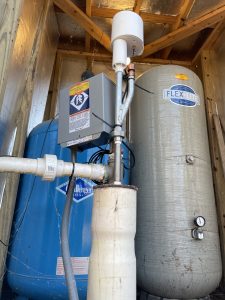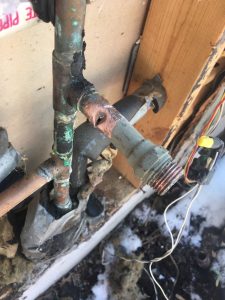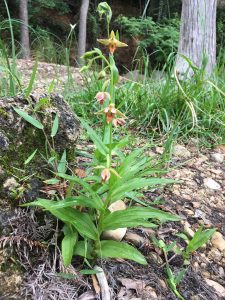Groundwater Wells
Well owners are independently responsible for monitoring and maintaining their wells. There are many agencies and resources available to help. From well-servicers to local groundwater conservation districts and national agencies, here is a list of useful links.
-
-

Water well drillers and pump installers list: Texas Department of Licensing and Regulation has a searchable index of licensed professionals online. Select Water well drillers and pump installers and specify which county for best results.
- EPA Private Well Owners page: Water quality and maintenance practices.
- Texas Well Owner Network: Texas A&M AgriLife hosts trainings and publishes guidance for well owners.
- Solving Water Quality Problems in the Home: Publication discussing Water treatment system options and what contaminants they address.
- National Groundwater Association’s WellOwner.org fact sheets:
- Groundwater Conservation Districts:
- Hays Trinity Groundwater Conservation District
- Blanco Pedernales Groundwater Conservation District
- Comal Trinity Groundwater Conservation District
- Barton Springs Edwards Aquifer Conservation District
- Edwards Aquifer Authority
- Texas Water Development Board – groundwater conservation districts facts, links, and map
-
Leak Detection
Texas’ weather often sends homeowners chasing leaks and working to restore water service either because of brutal cold snaps or long droughts. Water utility customers can use their meters to check their plumbing integrity, but well owners will have a harder time verifying that all leaks have been found. Groundwater levels in our aquifers are low, and the NOAA Climate Prediction Center forecasts that drought will persist in our area at least through the spring if not longer, so finding leaks will help secure our water supplies and protect Hill Country springs, creeks, and rivers. Here’s how:

Homeowners served by a water utility, pick a two-hour timeframe your whole household can avoid using water. Read your meter (take a photo). After two hours of no water use, read it again and compare it to your previous reading. With no leak, the number should be the same. With a leak or leaks, the meter will show your unintentional water use. If these leaks continue, they will needlessly increase your water bill and deplete water storage in our aquifers.
Well owners, without a meter hidden leaks are more difficult to identify. While not using water, go out to your well house to monitor the pressure tank and listen for the well pump to cycle. If there is no leak, pressure should remain steady and the pump should not have to cycle. A leak would drain water from the pressure tank, and it would lose pressure over time. If you would like to have a professional examine your system, a list of licensed pump and well-servicers is available through the Texas Department of Licensing and Regulation. If a leak or leaks continue, costly well and septic system components could wear out faster than with normal use and the increased water use could pointlessly deplete groundwater supplies.
The Texas Hill Country is drought-prone and groundwater-dependent. Fixing hidden leaks now has benefits at multiple scales—from individual homes to neighborhoods and the region.
-
- EPA Fix-A-Leak page: The average household’s leaks can account for nearly 10,000 gallons of water wasted every year and ten percent of homes have leaks that waste 90 gallons or more per day. This page has important guidance for finding leaks and fixing them.
- Using your meter to check for leaks (video): An expert with the Regional Water Providers Consortium video shows how to use a water meter to check for a leak.
Landscaping

-
- Grow Green Plant Guide: A searchable catalog of drought-tolerant, deer-resistant, and native plant options for Central Texas. Grow Green is a gardening education program that promotes sustainable landscaping practices. It addresses water quality and conservation, recycling, encourages using the right plant in the right place and the least impact-related way to address pest issues.
- Ask Mr. Smarty Plants: Ladybird Johnson Wildflower Center staff and volunteers have compiled recommended native plant discussion forums, plant ID guides, and frequently asked questions.
- WaterMyYard app: Over 50% of landscape water is wasted due to overwatering, inefficient watering practices, and broken or poorly maintained irrigation systems. Texas A&M AgriLife developed the Water My Yard app to help homeowners without native landscaping determine exactly how much to water, conserving water resources for the future and saving money right now.
- SEEK Identification app: Informed by iNaturalist observations, the SEEK app empowers a smartphone camera with image recognition technology to identify the plants and animals.
- Riparian Landscape Restoration video: Hill Country Alliance and Texas Parks and Wildlife provide best practices for restoring native vegetation to benefit habitat and water quality in riparian areas.
Gardening
-
- Ollas – ancient, local drip irrigation for your garden! Ollas are clay pots that are buried in the garden soil, then filled with water. They slowly release water to the surrounding plants, just like drip irrigation. They minimize evaporation and provide steady moisture to growing plants.
- Hays County Master Gardeners: A volunteer group that offers advice, plant sales, and educational opportunities focused on gardening strategies tailored to Hays County.
Topics coming soon:
-
- Septic Systems
- Rainwater Catchment
- Water treatment
- Back-up power options